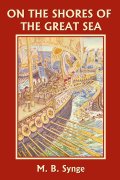M.B. Synge’s five volume world history, originally published in 1903, has been reprinted by Yesterday’s Classics. This series can be read independently by students about fifth grade and up, and most of them can be read aloud to students as young as fourth grade. With a style similar to Hillyer’s A Child’s History of the World and Wise-Bauer’s Story of the World, these are very enjoyable to read and might be enjoyed even by older students up into high school. Titles of the five volumes are:
- On the Shore of the Great Sea
- The Discovery of New Worlds
- The Awakening of Europe
- The Struggle for Sea Power
- The Growth of the British Empire
Together they cover ancient history up through the end of the nineteenth century. They do so selectively by telling the stories of key events and people. Synge makes connections between world events in a manner somewhat like Genevieve Foster’s so children can identify events happening in proximity to each other even though separated geographically.
The first book, On the Shore of the Great Sea, covers ancient history from Abraham till the birth of Christ. Stories are drawn primarily from the Old Testament as well as Greek and Roman History and mythology. Because some of the content is likely already familiar from Bible stories, and other material is drawn from stories such as The Odyssey, I think I would read this aloud to students as young as third grade.
The Discovery of New Worlds covers the immense time period from the height of the Roman Empire to the sixteenth century. It begins by summarizing the rise and fall of the Roman Empire in conjunction with the spread of Christianity. A brief look at the barbarians and the descent into the “dark ages” is followed by selective stories such as those of King Arthur, Charlemagne, William the Conqueror, The Crusades, Marco Polo, Dante’s Divine Comedy, Joan of Arc, the invention of printing, El Cid, Vasco Da Gama, Columbus, the defeat of the Moors in Spain, Magellan, Cortez, and Pizarro. It concludes with praise for the dawning Enlightenment. While the selected stories provide a fairly coherent series of “snapshots” of world history that might be appropriate for students in the elementary grades, older students need more comprehensive coverage.
The third book, The Awakening of Europe, has a strongly Protestant bias as it covers the narrower time span of 1520 through 1745. The Reformation is a major theme in the first part of the book. The rest of book has many stories of England and her conquests, but it also has some stories of the exploration and colonization of America as well as some about other European countries and Russia.
The Struggle for Sea Power begins with praise for England’s conquest of India then shifts to the struggle for North America and the rebellion of the American colonies. It shifts again to the French Revolution, then Napoleon. Synge writes other stories of the British Empire that took place during the time of Napoleon, such as the first Australian colony. But the battle between England and Napoleonic France is a major thread. The book concludes with Napoleon’s exile and death.
Even though the last volume is titled The Growth of the British Empire, it also treats some other world events such as the United States’ westward expansion, the Mexican Revolution, Dutch Republics in South Africa, and the “freeing” of Cuba and the Philippines from Spanish control. There is definitely a bias in favor of colonialism, especially colonialism controlled by Great Britain. While this was a bias prevalent at the time these books were written, it might sound offensive to modern readers. You might use this bias for critical thinking instruction to help your children learn to identify bias in this and other things they read.
Personally, I like the first two volumes the most and would probably use these as read-alouds for children beginning at third grade with the first book, although you could start later. I might use the other volumes more selectively, maybe skipping some of the stories and supplementing with broader coverage of world history.














